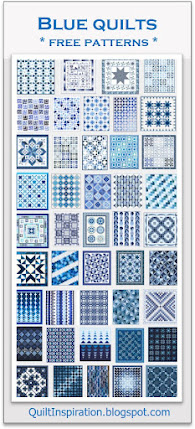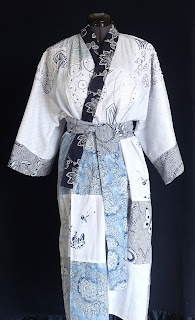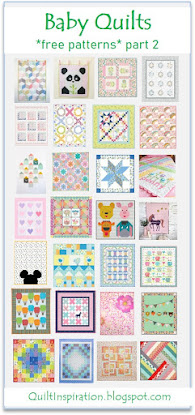Some quilts we make for the fun and frolic of the present day. Some quilts we make to be handed down to following generations as heirlooms. For those quilts, the hard work involved seems a small price to pay to preserve our legacy as quilters, as each of us would like to be remembered when we leave this earth. We like to think that our fore mothers undertook the arduous practice of making an heirloom quilt as a tribute to their families and as a way of leaving their mark for the ages and the future.
Maze Quilt, c. 1850, 83-1/2 x 79-1/2", by Margaret Cabell McClelland. Courtesy of the DAR Museum
Born in 1785 and married to Thomas McClelland in 1820, Margaret Cahill McClelland constructed this labyrinth quilt in about the year 1850, when she would have been 65 years old. The intricate pattern needs strong contrasting colors so that the design is clearly evident to the viewer. We like to think that Margaret chose bright red as a way to protect the design from fading into pale oblivion, as earth tones or blues might have done over the ensuing years.
The design of the maze was based on a mosaic floor at Amiens Cathedral in France*, as noted on this Quilt Index Page. Margaret hand appliqued each of the red strips into place, in such a way that it is exactly parallel to its neighboring strip. It is this devotion to accuracy that gives this quilt such a precise, orderly geometric effect. To add visual interest and diversity, she appliqued a Greek Key border around the outside of the maze, which helps the eye transition to the lines around the outside of the quilt.
The Maze Quilt is in the permanent collection of the Daughters of the American Revolution Museum ( D.A.R.) in Washington, DC, which preserves outstanding crafts and furniture of early America. It was displayed in an exhibit titled “The D.A.R.Museum Collection: Quilts from a Young Country” at the 2008 International Quilt Festival in Houston, Texas.
Are any of you planning to make or making a quilt specifically for the purpose of passing it along to your loved ones or friends? Or, are all of your quilts meant to be legacy quilts? We'd love to hear stories about any quilts that you have in mind for future generations. Please feel free to leave remarks in the Comments section below.
Image credits: The quilt image is copyrighted, and is shown with permission of the DAR Museum. *The original labyrinth pavement, which dated to 1288, was destroyed in 1825 and restored in 1894. The above photo of the Amiens Cathedral floor is from the Mt. Holyoke University website. A description of the labyrinth is at the Loyola University Medieval Studies website. A diagram of the labyrinth can be seen at Labyrinthos.
Wednesday, February 16, 2011
Subscribe to:
Post Comments (Atom)














That is one amazing quilt! It looks like that floor could provide a lifetime of inspiration.
ReplyDeleteI'm afraid I haven't given much thought to what will happen to my quilts after I'm gone - I'm too busy focusing on my need to make them :)
They are so lovely all those red quilts, red is my color !!!
ReplyDeleteall of the quilts that I make will eventually be split between my daughters and the grandchildren - I hope they will be used and not packed away - the only two I have a feeling that will not be used much are the two dear jane quilts that I have made as the girls know how much time and effort went into making them. Most I make though with the intention of being used
ReplyDeleteKaren
http://karensquilting.com/blog/
I'm so glad I added you guys to my sidebar yesterday, I know I am going to love this blog - so interesting and so different and I had never heard of maze quilts before - thank you for the insight.
ReplyDeleteI used to make quilts for the babies and young children in my family. Now in addition to simple/everyday quilts - I am trying to complete one SPECIAL piece a year (such as my Dear Jane) to leave as a legacy for my family.
ReplyDeleteI made a Labyrinth Quilt based on the Rose Labyrinth at Chartres Cathedral. I used reverse applique but used a back-basting technique I devised myself called Trace and baste. You can see the quilt here if you're interested.
ReplyDeletehttp://sewjournal.com/2010/08/03/the-unveiling-of-the-labyrinth-quilt/
I hope you like it.
Hi Munaiba, thank you so much for the link to your labyrinth quilt. It is fantastic! We haven't seen one like this, ever. Your work is beautiful and very creative. Now we're off to check out more of your posts. Thank you.
ReplyDeleteIn 2006 I made a quilted banner with a labyrinth super-imposed on a Native American medicine wheel.
ReplyDeleteA maze gives choices of paths but the labyrinth is more used for meditation and follows one way to the center and the same way out. That quilt is truly a maze.(or should I say, amazing)
Thank you, everyone, for your wonderful comments. We find them to be most enlightening, and we're always so glad to hear from you.
ReplyDeleteBest wishes, from Marina and Daryl
I came to you via Esch House Quilts. I am working on a quilt based on the Cone Nebula, and I'm thinking of it as my "legacy" quilt.
ReplyDelete